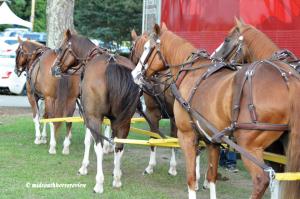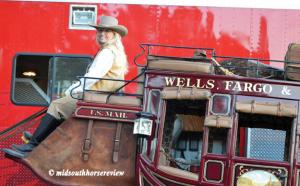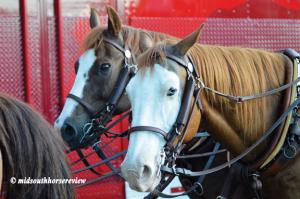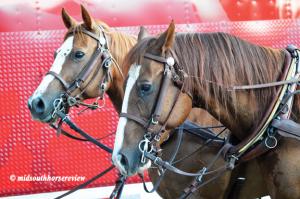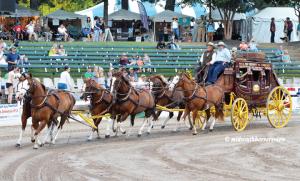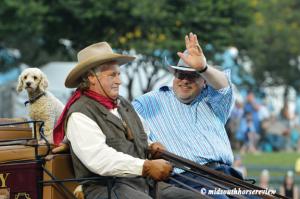By Nancy Brannon
A special treat for visitors to the 70th anniversary of the Germantown Charity Horse Show (GCHS) was the Wells Fargo Stagecoach, performing nightly, with a separate Stagecoach on the grounds for taking photos of family and friends. The stagecoach and six-horse team are a trademark of the company, and they make appearances at events all over the country. In fact, Wells Fargo sponsors three rigs: six horses each with stagecoaches and trucks.
Alan Cartwright and his wife Georgia, who train and drive the Wells Fargo rigs, brought two teams, 12 horses, and two stagecoaches to the GCHS this year. All the horses in the team are Quarter Horses and Paints – with a lot of white on them. They drive only geldings, which Alan calls “stocking leg” geldings (because of all the white on their legs).
The pair own and operate the Cartwright Ranch in Fort Worth, Texas, where they have about 40 head of horses on100 acres. They also raise a few Longhorns, but “the horses keep us busy,” Alan said.
The Cartwrights do their own training, buying new horses for the team as babies. They don’t buy any horse that is broke. Alan said they have at least six to eight new horses to start. “We love and feed them for two years before we start training. We like to get them before anyone has put a bad habit on them.”
They start training at about three years of age. “We expose them to everything we can, even fire trucks,” Alan explained. “We expose them to gun fire, fire crackers, balloons, and lots of John Philip Sousa music.” They drive the horses for two years at home before taking them to their first parade, at about five years of age, because “there’s no room for error!” Alan emphasized.
When he’s been driving a team for a couple of years, he finds out who’s going to be a good lead horse. “You want the most aggressive horses in front and you want the more casual, laid back horses for the wheel horses (in the back). In the middle are the swing horses. The bigger horses are in the back because they are the main horses actually pulling the 2500-pound coach. The wheel and swing horses do the pulling and the lead horses are the primary steering horses.”
Driving the horses around the GCHS arena is a particular challenge. “When driving around the arena, you keep the horses in an arc. For example, the lead horses to the left and the swing/wheel horses to the right. So you’re actually driving all six horses.”
One interesting fact is that they don’t use “blinds” (blinders) on the horses, Alan said. He wants the horses to be able to see each other and where they are going. He said “blinds” started in England to protect the eyes of the wheel pair from the lead pair’s reins. People started putting the family crest on them and they became a popular tradition. For his horses, “if they can see children coming toward them, there is less reaction from the horses than if they have blinders on.” Alan said lots of children run up to the horses and want to pet them under the belly. “It takes a few days for them to get used to the rig following them, then it’s over.” (No longer need the blinders)
Alan said the coaches are all built by Abbott and Downing in Concord, New Hampshire, thus the body style is called the “heavy Concord.” “You could haul 9 passengers in this coach,” Cartwright said, referring to the Concord stagecoach. Hanson also builds stagecoaches in South Dakota.
Alan started working for Wells Fargo in 1995 in the Stagecoach Experience division, but his experience with horses goes farther back. He grew up in the horse business, farming and ranching. At age 6, he learned trick riding and has been performing ever since.
He has been a member of the Screen Actors Guild since 1973 and has worked in many aspects of the movie industry. He has provided horses and livestock for a number of movies, as well as driving for the movie industry in the Dallas area. He collects wagons, carriages, buggies, and even a hearse for funerals, all of which he leases to the movie industry. He was even a stunt double for Clint Eastwood in the 1979 movie “Bronco Billy.”
His wife Georgia also drives the six-horse rig. “In the old days, very few ladies drove; in fact, only two. Georgia is only the third lady driver of a Wells Fargo Stagecoach.”
June, 2018 marks the 60th year for the Wells Fargo Stagecoach promotional program. Wells Fargo was founded in 1852 during the California Gold Rush to mainly transport gold from the mines to the banks. Later, they expanded to transporting the U.S. mail and passengers. One of the main routes went from San Francisco to St. Louis, which took 21 days, traveling 24 hours a day at an average speed of five miles per hour. The coach could carry up to 18 passengers, and stopped every 12 to 18 miles to change horses. About every 45 miles the stagecoach stopped at the “Home Station,” which provided meals for the passengers.”
Alan says he enjoys the work and never gets tired of it. “We start early and stay late,” he said. Alan and Georgia travel with their teams across the country, mainly in the South – from Texas to Kansas and along the east coast. They have been to the Belmont Stakes and traveled to London in 2012 for a parade with the Queen. They also did some “touristing” while there, visiting the harness making shop, toured the Royal Mews, and met the driver of the Queen’s carriage.
After the GCHS, the couple hauled to their next stops on the tour, one in Florida and the other to Louisville, Kentucky. The pair participates in about 100 parades a year. Christmas and 4th of July are the most popular times for their stagecoach appearances.
Read more about the Cartwrights at: http://www.cartwrightranch.com/
A special treat for visitors to the 70th anniversary of the Germantown Charity Horse Show (GCHS) was the Wells Fargo Stagecoach, performing nightly, with a separate Stagecoach on the grounds for taking photos of family and friends. The stagecoach and six-horse team are a trademark of the company, and they make appearances at events all over the country. In fact, Wells Fargo sponsors three rigs: six horses each with stagecoaches and trucks.
Alan Cartwright and his wife Georgia, who train and drive the Wells Fargo rigs, brought two teams, 12 horses, and two stagecoaches to the GCHS this year. All the horses in the team are Quarter Horses and Paints – with a lot of white on them. They drive only geldings, which Alan calls “stocking leg” geldings (because of all the white on their legs).
The pair own and operate the Cartwright Ranch in Fort Worth, Texas, where they have about 40 head of horses on100 acres. They also raise a few Longhorns, but “the horses keep us busy,” Alan said.
The Cartwrights do their own training, buying new horses for the team as babies. They don’t buy any horse that is broke. Alan said they have at least six to eight new horses to start. “We love and feed them for two years before we start training. We like to get them before anyone has put a bad habit on them.”
They start training at about three years of age. “We expose them to everything we can, even fire trucks,” Alan explained. “We expose them to gun fire, fire crackers, balloons, and lots of John Philip Sousa music.” They drive the horses for two years at home before taking them to their first parade, at about five years of age, because “there’s no room for error!” Alan emphasized.
When he’s been driving a team for a couple of years, he finds out who’s going to be a good lead horse. “You want the most aggressive horses in front and you want the more casual, laid back horses for the wheel horses (in the back). In the middle are the swing horses. The bigger horses are in the back because they are the main horses actually pulling the 2500-pound coach. The wheel and swing horses do the pulling and the lead horses are the primary steering horses.”
Driving the horses around the GCHS arena is a particular challenge. “When driving around the arena, you keep the horses in an arc. For example, the lead horses to the left and the swing/wheel horses to the right. So you’re actually driving all six horses.”
One interesting fact is that they don’t use “blinds” (blinders) on the horses, Alan said. He wants the horses to be able to see each other and where they are going. He said “blinds” started in England to protect the eyes of the wheel pair from the lead pair’s reins. People started putting the family crest on them and they became a popular tradition. For his horses, “if they can see children coming toward them, there is less reaction from the horses than if they have blinders on.” Alan said lots of children run up to the horses and want to pet them under the belly. “It takes a few days for them to get used to the rig following them, then it’s over.” (No longer need the blinders)
Alan said the coaches are all built by Abbott and Downing in Concord, New Hampshire, thus the body style is called the “heavy Concord.” “You could haul 9 passengers in this coach,” Cartwright said, referring to the Concord stagecoach. Hanson also builds stagecoaches in South Dakota.
Alan started working for Wells Fargo in 1995 in the Stagecoach Experience division, but his experience with horses goes farther back. He grew up in the horse business, farming and ranching. At age 6, he learned trick riding and has been performing ever since.
He has been a member of the Screen Actors Guild since 1973 and has worked in many aspects of the movie industry. He has provided horses and livestock for a number of movies, as well as driving for the movie industry in the Dallas area. He collects wagons, carriages, buggies, and even a hearse for funerals, all of which he leases to the movie industry. He was even a stunt double for Clint Eastwood in the 1979 movie “Bronco Billy.”
His wife Georgia also drives the six-horse rig. “In the old days, very few ladies drove; in fact, only two. Georgia is only the third lady driver of a Wells Fargo Stagecoach.”
June, 2018 marks the 60th year for the Wells Fargo Stagecoach promotional program. Wells Fargo was founded in 1852 during the California Gold Rush to mainly transport gold from the mines to the banks. Later, they expanded to transporting the U.S. mail and passengers. One of the main routes went from San Francisco to St. Louis, which took 21 days, traveling 24 hours a day at an average speed of five miles per hour. The coach could carry up to 18 passengers, and stopped every 12 to 18 miles to change horses. About every 45 miles the stagecoach stopped at the “Home Station,” which provided meals for the passengers.”
Alan says he enjoys the work and never gets tired of it. “We start early and stay late,” he said. Alan and Georgia travel with their teams across the country, mainly in the South – from Texas to Kansas and along the east coast. They have been to the Belmont Stakes and traveled to London in 2012 for a parade with the Queen. They also did some “touristing” while there, visiting the harness making shop, toured the Royal Mews, and met the driver of the Queen’s carriage.
After the GCHS, the couple hauled to their next stops on the tour, one in Florida and the other to Louisville, Kentucky. The pair participates in about 100 parades a year. Christmas and 4th of July are the most popular times for their stagecoach appearances.
Read more about the Cartwrights at: http://www.cartwrightranch.com/
